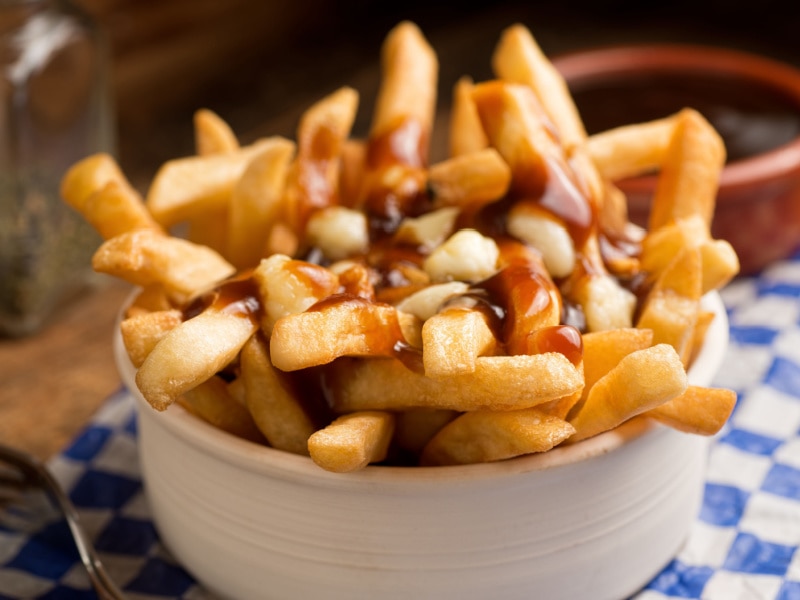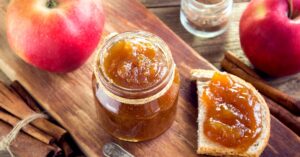Known for its beautiful scenery, maple syrup, and love for hockey, Canada is the place to go for warm, cheesy poutine.
But what is poutine, eh?

Poutine is a dish of thick-cut french fries topped with cheese curds and gravy.
Many poutine restaurants in Canada offer variations with veggies, bacon, chili, pulled pork, and more.
It’s messy. It’s savory. And it’s a carb-lovers dream!
Ask any Canadian, and they’ll tell you all about it. It may not be the official dish of the Great White North, but it might as well be.
So, whether you’re a first-timer or a die-hard fan, let’s explore all things poutine.
What Is Poutine?
Poutine is a popular type of Canadian pub food. Though it can also be found in many restaurants and sports stadiums across the country.
It features a mound of crispy fries covered in squeaky cheese curds and plenty of gravy.
It’s thought to have been invented in Quebec in the 1950s, as the name ‘poutine’ is Quebecois slang for ‘mess’.
I first had poutine when I was visiting Toronto a few years ago. And I was hooked after just one bite!
It’s hugely popular in Canada, though other countries actually have something similar, like ‘chips, cheese, and gravy’ in Northern England.
Though that usually calls for grated Manx Cheddar cheese, not curds.
But back to Canada – this is the dish to order if you’re visiting our neighbors to the North.
And if the mix of curds and gravy gives you pause, fear not.
You’ll find all kinds of variations, including add-ins like bacon, maple syrup, avocado, duck, eggs, and even lobster.
It might be a calorie bomb, but it’s absolutely scrumptious!

What Are Cheese Curds?
When it comes to poutine, cheese curds are non-negotiable. Without it, you’d just be eating fries with gravy.
And while that’s arguably tasty, it isn’t poutine.
But if you didn’t grow up in Canada, you might not be super familiar with cheese curds.
What do they taste like? How are they made? And why is it called squeaky cheese?
Luckily for you, I’m well-versed in all things cheese!
Cheese curds are pieces of fresh, young cheddar that have not been aged.
Instead, they’re made from curdled milk, as the curd separates from the whey while making cheese. But instead of forming into blocks and aging, they’re cut into chunks and sold young, giving them a very mild flavor.
How to Make Cheese Curds
You see, when cheesemakers add acid and rennet to milk (to make the curd firmer), it starts to coagulate and form clumps.
These solids are separated from the liquid, then pressed to remove the rest of the whey.
What’s left are delicious morsels of fresh cheese curds.
So they’re technically a byproduct of the cheese-making process. But they’ve grown in popularity in recent years.
Common in Canada and the Midwest, cheese curds are also known as squeaky cheese. As you might guess, that’s because they squeak when you bite them,

History of Poutine
Like many other iconic creations, the exact origins of poutine are up for debate.
Warwick
One story suggests it came from Warwick in the 1950s when a regular at the restaurant Le Lutin qui rit requested cheese curds on his fries.
The owner reportedly exclaimed, “Ca va faire une maudite poutine”!
In English, that means something akin to “it will make a damn mess”.
Drummondville
Another version comes from Drummondville in the 1960s.
Supposedly, the owner of a drive-in restaurant, Le Roy Jucep, noticed customers adding cheese curds to his signature dish, patate-sauce (fries with a special sauce).
He sold curds in bags as snacks and quickly added the unique dish to his menu as fromage-patate-sauce.
Princeville
One last story is similar to the first and kind of a mix of Warwich and Drummondville.
In Princeville in the 1960s, cheese curds were produced at a local cheese dairy and needed somewhere to sell them.
So, the restaurant La P’tite Vache bagged them and sold them at the cash register.
Rumour has it, a regular bought a bag and mixed them with a portion of fries.
Quebec
Whether any of the above stories are true or not, the one thing we know for sure is poutine was born in Quebec.
And considering dairy farms are prevalent in the area, it’s not too surprising.
What may be surprising is how quickly the trend spread. From region to region, it became a favorite throughout Canada.
But Canadians aren’t the only ones devouring this stuff!
Poutine has gained worldwide popularity. And rightfully so, it’s delicious.

What Does Poutine Taste Like?
Ask anyone who’s had poutine, and they’ll tell you it’s distinctly unique.
And to be honest, what it tastes like depends on the maker.
Poutine tastes strongly of beef gravy since it’s poured over the whole dish.
However, the more you eat, the more mild cheddar and salty fries you taste. Of course, the types of curds and gravy can change the overall flavor.
For example, some places don’t use beef gravy, giving it a milder flavor.
When done right, there’s no denying it’s utterly irresistible.
Each bite is savory, salty, and carby-licious mixed with chunks of fresh mild cheese.
No matter the version, poutine tastes like the epitome of comfort food.
How to Make Poutine
Poutine consists of three things: fries, gravy, and cheese curds. So to make it, simply add all three to a dish and serve them hot.
- Make the fries.
- Add the fries to a dish.
- Top with plenty of cheese curds.
- Pour the hot gravy over the top.
- Serve and enjoy!
Thick fries hold up best to a hefty ladle of gravy and chunks of cheese curds. So you’ll most often see thick-cut steak fries under all that yumminess.
For gravy, beef is the most common type, though you can use any you like best.
As for the curds, the fresher, the better.
If you detest soggy fries, leave the gravy on the side for dipping.
However you make it, grab a fork and dig in! This stuff is just a touch too messy to eat with your hands.











